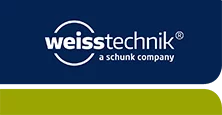A leading international testing and certification company has set up a new testing centre in the US. It houses testing facilities for various tests in the automotive sector. The largest test systems include three vibration test systems with 350 and 200 kN shakers for testing batteries for electric vehicles. Weiss Technik has developed and supplied the appropriate vibration test chambers with safety equipment in accordance with Hazard Level 5.
To equip the new multi-test centre, the customer, in collaboration with a general contractor, was looking for a specialist to supply three large vibration test chambers for temperature tests. These test facilities are used to test Li-ion battery packs for electric vehicles in the temperature range from −40 to +85°C in accordance with IEC 60068-3-5. The prerequisite for this is that the test specimens are controlled and operated in their limit ranges via the battery management system during the test procedure.
Building blocks for a customised concept
After intensive preliminary discussions on the requirements profile of the three testing systems, Weiss Technik developed a suitable system, operating, and safety concept. The dimensions of the system, with a usable volume of the test chambers of 14.3 m3 each, are precisely tailored to the size of the two different shaker types (350 kN and 200 kN). These shakers move the test specimens along the X-, Y-, or Z-axis. The right exchangeable base for adaptation between chamber and shaker is available for every application. Feed-throughs for cables to supply the test specimens and for additional test equipment are installed in the test chambers.
Expertise and production from a single source
The large test bay comprises three test systems, each with a travel distance of 14 m. As a specialist for high-quality testing systems, Weiss Technik designed the chamber for the test specimens, the machine unit for the system technology, and the complete steel construction for the traversing of all system parts and manufactured them in house. The test chambers of the system are made from high-quality stainless steel and each have a usable interior space of approx. 3,000 × 1,600 × 3,200 mm (W × H × D). Also the upstream 3D simulation, including collision check and FEM methods for the design of the load-bearing components, were co-developed.
Dealing with large test specimens
Testing can now be carried out in a temperature range from −55°C to +90°C with a change rate of approx. 5–6 K without test specimen or 2 K with test specimen in accordance with IEC 60068-3-5. With a test area of approx. 9.6 m2, large test specimens such as the customer’s battery packs with dimensions of 2,500 × 750 × 1700 mm (W × H × D) and a mass of up to 1.3 t can be tested without any problems. An on-site pit measuring 8,000 × 1,200 × 5,000 mm (W × H × D) is available in the hall for lowering and decoupling the shakers.
Integrated safety system for Hazard Level 5
The test arrangement with Li-ion batteries requires that the test spaces are equipped with suitable safety devices for Hazard Level 5. These include visual and audible alarm functions, electric door closures to prevent unauthorised opening during a test, and pressure relief flaps in the event of an emergency. In addition, the test chambers are equipped with a purge air system so that they can be purged with fresh air at the end of the test in order to remove any toxic gases that may have escaped during a test.
An integrated fire protection system with CO gas detection ensures the protection of persons, test systems, and test specimens. This signals a visual pre-alarm at 200 ppm as well as a visual and audible main alarm from 800 ppm. Faulty batteries often leak hydrocarbons (hydrocarbons, HC). A two-stage HC warning system therefore signals increased concentrations visually from 20% LEL and visually and acoustically from 40% LEL in order to warn others of the risk of explosion.
ShakeEvent stands for proven testing technology
The ShakeEvent concept is based on a tried-and-tested system concept and the many years of expertise of Weiss Technik, especially in the automotive sector. The test systems have an S!MPAC control system with WebSeason interface. This enables the simple programming of test sequences, has a multi-user function, and allows worldwide access via tablet or computer. The air flow ensures a high temperature consistency in the test space. The test system was supplied with the refrigerants R449A and R469A and a maximum GWP value of only 1,397. This means that it is future-proof and can be operated without any problems – even after 2030.
Reprint free of charge. Please cite Weiss Technik GmbH as the source.

